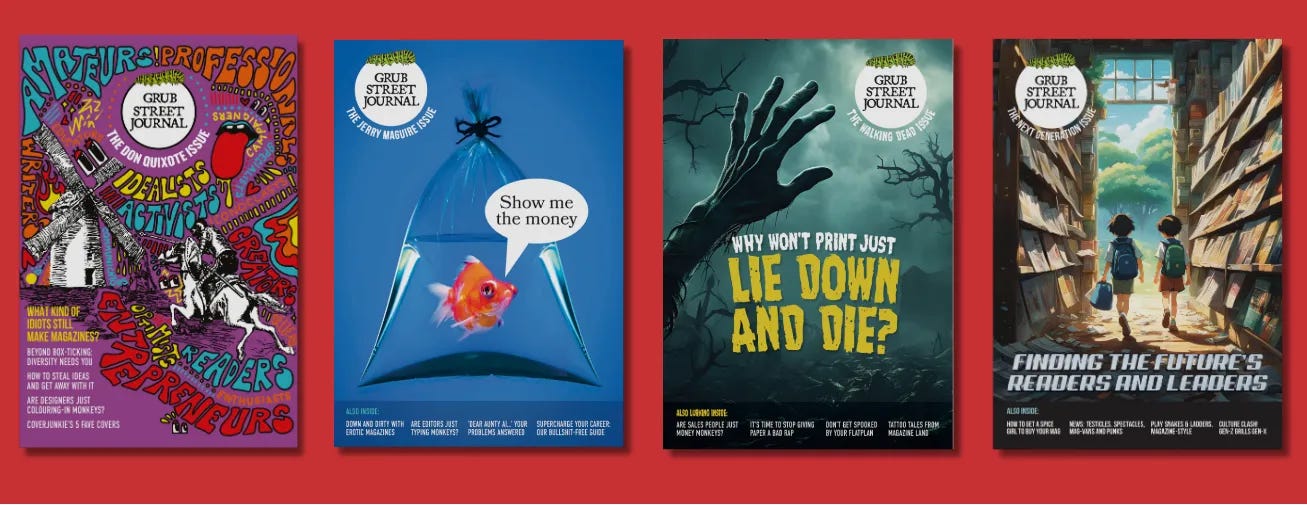Are newsletter dates very important?
Plus Katie Vanneck-Smith tells me off and Tina Brown says magazines are mostly done
Hello magazine makers,
You might not have noticed - you might not care - but I’m still working on getting that Newsletter-Rhythm-Thing right. You should have had this newsletter yesterday.
If you care that it was late: thank you for your patience.
If you don’t care that it was late: just, thank you.
There are a hundred and one super-serious reasons for the rigidity of magazine publishing schedules.
Meeting subscriber expectations
Building retail habits
Making print and distribution slots
Keeping advertisers sweet
A solo side-hustle newsletter is a bit different.
I don’t have a printer or advertisers to keep happy. I don’t even have paying readers at this point and, thankfully, there is no newsletter newsstand.
However, I’m working hard on the weekly thing. I think I need to if I’m to keep my promise to future subscribers.
Hit reply and tell me what you think.
What Katie said
On Tuesday I spoke to Katie Vanneck-Smith, CEO at Hearst UK and one of the smartest reader revenue people on the planet. My full interview with Katie will be on The Publisher Podcast from Media Voices next week, but I had to share how Katie told me off for talking about publishers ‘extending the runway for print’.
“Stop talking it down Peter,” she scolded me.
“That sort of language worries me, because I think it stops us. Consumers are ultimately the people who will decide whether the joy of a physical product is something that that is part of their media diet.”
I deftly changed the subject and we spoke about about the difference between subscriptions and memberships, how to position a magazine membership and the importance of publishing teams.
But I had to return carefully to the question of print’s future and we got into artisanal print, the craft of making magazines and how print gives publishers the chance to be ‘perfect in a world where everyone is racing’.
She told me:
I'm very positive about print. I actually think for the majority of our brands, not all of our brands, but for the majority of our brands, it'll be a vital part of whatever that future membership proposition is.”
I’ll link to the interview next week, but sign up for The Publisher Newsletter to make sure you get it as soon as it’s out.
Want to know how people are making print magazines work in a digital world? Sign up to get The Magazine Diaries sent straight to your inbox every week.
Tina Brown says ‘magazines are mostly done’...
…but she still believes in the ‘intellectual serendipity’ of print and its ‘hierarchy of excitement’.
If you don’t know Tina Brown, she was the editor of Tatler aged just 25, then editor of Vanity Fair and The New Yorker and went on to found The Daily Beast.
In this interview with podcaster and journalist Pandora Sykes she says,
Sadly, I do think that magazines are mostly done. And it breaks my heart because, like you, I used to have a big pile of magazines to read each month… I’ve normally read it all on my phone, by the time I get to the magazine.
However, she also says,
I know that when I read the print edition, that kind of intellectual serendipity is far more nurturing, or nourishing, than just quickly looking at all the headlines, scrolling down them.
And,
Another thing I really miss about print is that digital journalism has no hierarchy of excitement. A front page is a meaningful thing, a big front page with a big headline and a big picture is this great moment that communicates excitement and communicates choice.
So, yes, magazines as they were back in the day are mostly done, but there’s still a room to be serendipitous and get people excited.
KBB’s Readly exclusive
There’s no point pretending: I’ve been known to question the value of newsstand apps like Readly. When I saw the company’s former Chief Content Officer Ranj Begley at Magazine Street last year she made a point to remind me.
While I think they can be a great deal for casual magazine readers, I’ve always been dubious about the value to magazine publishers. You’re fighting for attention among thousands of titles, discovery and reader loyalty are both a challenge. And on the revenue front, they might not be ‘Spotify bad’, but I can’t see how a magazine publisher can get rich on Readly.
Except… I’ve just read about Kitchens Bedrooms & Bathrooms' 100-page Readly Exclusive and I genuinely think that’s genius. Collated from the 12 months of KBB content, the team has created an ‘epic guide to kitchen design’ a strong introduction to the brand and the perfect reason for Readly to spotlight the title.
I want to know more. Get in touch Georgina.
Is your Grub Street collection complete?
We’ve published four editions of The Grub Street Journal.
The Don Quixote issue: What kind of idiots still make magazines?
The Jerry Maguire issue: Show me the money in magazines
The Walking Dead issue: Why won’t print just lie down and die?
The Next Generation issue: Finding the future’s readers and leaders
Magazine Songs
I have a Spotify playlist of songs that reference magazines… What? Music and magazines are two of my favourite things. If you have a favourite magazine song, just reply to this email and I’ll add it to The Grub Street Journal’s ‘Magazine Songs’ playlist.
This week, here’s a brilliant cover of Rihanna’s ‘Umbrella’ from Biffy Clyro.
‘MON the BIFFY.








In theory, I'd say that a Substack newsletter doesn't need to intentionally mimic the regular schedules of print publishing which, as you say, are grounded in the practical requirements of printers, wholesalers, retailers, advertisers, etc (the whole kit and caboodle of print publishing).
The focus should only be on finding some kind of acceptable balance between your own creative resources and ongoing audience expectations. I accept that the latter will certainly be influenced by the deeply embedded schedules and rhythms of traditional print publishing, but probably less so as older readers inevitably fall away from the market. Audiences will likely become more open to the "unexpected" appearance of a newsletter than we think. (I long ago learned patience when anticipating the arrival of a new Kate Bush album—basically, "it'll appear when it's ready".)
But you know all this. 😉
Tina Brown is wrong. And she's not wrong. But as a person with a podcast about magazines (The Full Bleed) I hope she's not wrong in the way I'm thinking but also wrong in the way she's thinking. Mostly.